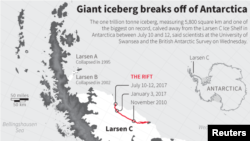ບັນດານັກວິທະຍາສາດກ່າວວ່າ ພູຫຼືແທ່ງນໍ້າກ້ອນທີ່ໃຫຍ່ສຸດຂອງໂລກ ກຳລັງລ່ອງລອຍ
ມຸ້ງໜ້າຢູ່ໃນເສັ້ນທາງ ທີ່ຈະຕຳເກາະຈໍເຈຍໃຕ້ທີ່ເປັນບ່ອນຢູ່ທີ່ສຳຄັນຂອງສັດປ່າ ທາງ
ພາກໃຕ້ຂອງມະຫາສະໝຸດ ແອັດແລນຕິກ. ເຂົາເຈົ້າກ່າວເພີ້ມວ່າ ມັນອາດເຮັດໃຫ້ມີຜົນ
ກະທົບຕໍ່ລະບົບນິເວດແລະເສດຖະກິດຂອງເກາະ.
ພູນໍ້າກ້ອນຂະໜາດໃຫຍ່ທີ່ຂາດອອກມາຈາກ ພູນໍ້າກ້ອນລາສັນ ຊີ (Larcen C) ຢູ່ທາງ
ພາກຕາເວັນອອກຂອງແຫຼມຂົ້ວໂລກໃຕ້ ໃນປີ 2017. ທີ່ໄດ້ໃສ່ຊື່ໂດຍ ບັນດານັກວິທະ
ຍາສາດວ່າ A68a ນັບແຕ່ນັ້ນມາໄດ້ໄຫຼລ່ອງໄປສູ່ເກາະຈໍເຈຍ ໃຕ້ ທີ່ເປັນເກາະທີ່
ສອກຫຼີກຂອງອັງກິດ.
ບັນດາຮູບພາບຈາກດາວທຽມສະແດງໃຫ້ເຫັນວ່າ ພູນໍ້າກ້ອນດັ່ງກ່າວຍັງຕິດກັນ ຢ່າງ
ແໜ້ນໜາຢູ່ ຊຶ່ງມີຄວາມຍາວປະມານ 150 ກິໂລແມັດ ແລະກວ້າງ 48 ກິໂລແມັດ ທີ່ກຳລັງ
ເດີນທາງນຶ່ງກິໂລແມັດຕໍ່ຊົ່ວໂມງ ແລະມຸ່ງໜ້າໄປສູ່ເສັ້ນທາງ ທີ່ຈະຕຳເກາະຈໍເຈຍໃຕ້່ ໃນ
ປະມານອີກ 30 ມື້.
ຄວາມເລິກຂອງມັນມີພຽງແຕ່ 200 ແມັດ ໝາຍຄວາມວ່າໄຫຼເຂົ້າໄກ້ກັບເກາະ ທີ່ສຸດ ແລະ
ພຶ້ນດິນຢູ່ນອກຝັ່ງ. ເກາະຈໍເຈຍໃຕ້ເປັນບ່ອນຢູ່ອາໃສ ທີ່ໃຫຍ່ຂອງ ພວກນົກເພັງກວິນ
(penguins) ແລະພວກແມວນໍ້າ ຫຼືຊຽລ (seals.)
ບ່່ອນຫາກິນຂອງເຂົາເຈົ້າອາດຖືກປິດລ້ອມ ໃນຂະນະທີ່ລະດູປະສົມພັນກຳລັງມາເຖິງ
ທີ່ນັກວິທະຍາສາດ ເກີເຣນທ໌ ທາລິງ (Geraint Tarling) ກ່າວໃນລາຍ ງານການສຳ
ຫຼວດຂົ້ວໂລກໃຕ້ອັງກິດ.
The world’s largest iceberg is on course to collide with the island of South Georgia, a key haven for wildlife in the south Atlantic Ocean, scientists say. They add it could have a grave impact on the ecology and economy of the island.
The giant iceberg carved off the Larsen C ice shelf on the eastern Antarctic peninsula in 2017. Named by scientists as A68a, it has since drifted toward South Georgia, a remote British island.
Satellite images show the iceberg is still largely intact. Some 150 kilometers long and 48 kilometers wide, it is traveling at one kilometer per hour and is on course to hit South Georgia in around 30 days.
Its shallow depth of only 200 meters means it could drift very close to the island and ground just offshore. South Georgia is home to huge colonies of penguins and seals. Their feeding grounds could be blocked just as breeding season gets underway, says scientist Geraint Tarling of the British Antarctic Survey.










